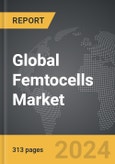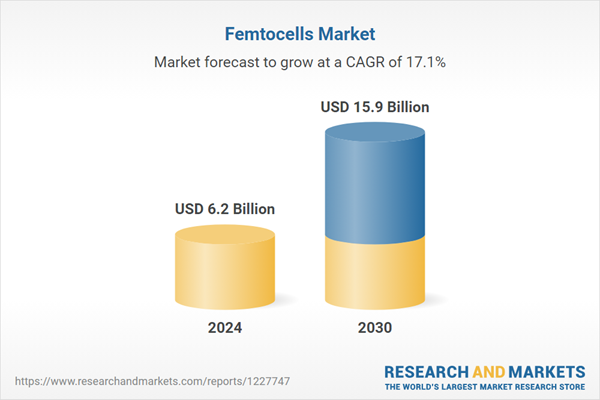The global market for Femtocells was estimated at US$6.2 Billion in 2024 and is projected to reach US$15.9 Billion by 2030, growing at a CAGR of 17.1% from 2024 to 2030. This comprehensive report provides an in-depth analysis of market trends, drivers, and forecasts, helping you make informed business decisions. The report includes the most recent global tariff developments and how they impact the Femtocells market.
The femtocell market is experiencing growth driven by the integration of advanced technologies such as artificial intelligence (AI) and the Internet of Things (IoT), enhancing the precision, safety, and convenience of telecommunications. These advancements facilitate significant improvements in network capacity and coverage, supporting high-bandwidth applications vital for remote work, video conferencing, and multimedia consumption. Additionally, the surge in smartphone use and the expansion of high-speed data services are increasing the demand for femtocells, which improve indoor mobile signal reception and network capacity. As consumer broadband becomes a ubiquitous platform, femtocells offer mobile operators a cost-effective way to enhance their services by leveraging existing broadband infrastructure, thus reducing capital expenditure and potentially increasing customer satisfaction.
The deployment of femtocells is set to play a critical role in the rollout of 5G networks, particularly in supporting the network`s need for densification and in ensuring ubiquitous coverage indoors and in urban settings where 5G’s high-frequency signals, such as mmWave, face penetration challenges. As smart home devices and IoT applications proliferate, the demand for continuous and reliable connectivity is growing, with femtocells positioned as a vital infrastructure to support the seamless operation of these technologies. Moreover, regulatory compliance and integration within fixed-mobile convergence (FMC) strategies underscore the importance of femtocells in the telecommunications sector, providing a seamless connectivity experience using existing mobile devices and enhancing the overall network ecosystem.
Global Femtocell Market - Key Trends and Drivers Summarized
Femtocells, small, low-power cellular base stations, are crucial in enhancing in-building cellular connectivity, particularly in residential or small business environments. By connecting to a service provider’s network via broadband connections such as DSL or fiber, femtocells extend service coverage indoors where traditional network signals may falter. As global demand for reliable mobile data consumption and uninterrupted indoor wireless coverage grows, femtocells are becoming increasingly vital. The technology is especially useful in densely populated urban areas where deploying additional macro base stations is economically and logistically challenging, and in energy-efficient buildings where cellular signals struggle to penetrate.The femtocell market is experiencing growth driven by the integration of advanced technologies such as artificial intelligence (AI) and the Internet of Things (IoT), enhancing the precision, safety, and convenience of telecommunications. These advancements facilitate significant improvements in network capacity and coverage, supporting high-bandwidth applications vital for remote work, video conferencing, and multimedia consumption. Additionally, the surge in smartphone use and the expansion of high-speed data services are increasing the demand for femtocells, which improve indoor mobile signal reception and network capacity. As consumer broadband becomes a ubiquitous platform, femtocells offer mobile operators a cost-effective way to enhance their services by leveraging existing broadband infrastructure, thus reducing capital expenditure and potentially increasing customer satisfaction.
The deployment of femtocells is set to play a critical role in the rollout of 5G networks, particularly in supporting the network`s need for densification and in ensuring ubiquitous coverage indoors and in urban settings where 5G’s high-frequency signals, such as mmWave, face penetration challenges. As smart home devices and IoT applications proliferate, the demand for continuous and reliable connectivity is growing, with femtocells positioned as a vital infrastructure to support the seamless operation of these technologies. Moreover, regulatory compliance and integration within fixed-mobile convergence (FMC) strategies underscore the importance of femtocells in the telecommunications sector, providing a seamless connectivity experience using existing mobile devices and enhancing the overall network ecosystem.
SCOPE OF STUDY:
The report analyzes the Femtocells market in terms of units by the following Segments, and Geographic Regions/Countries:- Segments: Technology (IU-H, IMS / SIP); Application (Commercial, Consumer, Public Space)
- Geographic Regions/Countries: World; United States; Canada; Japan; China; Europe (France; Germany; Italy; United Kingdom; Spain; Russia; and Rest of Europe); Asia-Pacific (Australia; India; South Korea; and Rest of Asia-Pacific); Latin America (Argentina; Brazil; Mexico; and Rest of Latin America); Middle East (Iran; Israel; Saudi Arabia; United Arab Emirates; and Rest of Middle East); and Africa.
Key Insights:
- Market Growth: Understand the significant growth trajectory of the IU-H segment, which is expected to reach US$10.3 Billion by 2030 with a CAGR of a 18.2%. The IMS / SIP segment is also set to grow at 15.2% CAGR over the analysis period.
- Regional Analysis: Gain insights into the U.S. market, valued at $1.6 Billion in 2024, and China, forecasted to grow at an impressive 23.0% CAGR to reach $3.9 Billion by 2030. Discover growth trends in other key regions, including Japan, Canada, Germany, and the Asia-Pacific.
Why You Should Buy This Report:
- Detailed Market Analysis: Access a thorough analysis of the Global Femtocells Market, covering all major geographic regions and market segments.
- Competitive Insights: Get an overview of the competitive landscape, including the market presence of major players across different geographies.
- Future Trends and Drivers: Understand the key trends and drivers shaping the future of the Global Femtocells Market.
- Actionable Insights: Benefit from actionable insights that can help you identify new revenue opportunities and make strategic business decisions.
Key Questions Answered:
- How is the Global Femtocells Market expected to evolve by 2030?
- What are the main drivers and restraints affecting the market?
- Which market segments will grow the most over the forecast period?
- How will market shares for different regions and segments change by 2030?
- Who are the leading players in the market, and what are their prospects?
Report Features:
- Comprehensive Market Data: Independent analysis of annual sales and market forecasts in US$ Million from 2024 to 2030.
- In-Depth Regional Analysis: Detailed insights into key markets, including the U.S., China, Japan, Canada, Europe, Asia-Pacific, Latin America, Middle East, and Africa.
- Company Profiles: Coverage of players such as AirWalk Communications, Analog Devices, Inc., Cisco Systems, Inc., Gemtek Technology Co. Ltd., Huawei Technologies Co., Ltd. and more.
- Complimentary Updates: Receive free report updates for one year to keep you informed of the latest market developments.
Some of the 79 companies featured in this Femtocells market report include:
- AirWalk Communications
- Analog Devices, Inc.
- Cisco Systems, Inc.
- Gemtek Technology Co. Ltd.
- Huawei Technologies Co., Ltd.
- Juniper Networks Inc.
- Motorola Solutions, Inc.
- NETGEAR, Inc.
- Nokia Corporation
- Rakon Ltd.
- Telefonaktiebolaget LM Ericsson
- ZTE Corporation
This edition integrates the latest global trade and economic shifts as of June 2025 into comprehensive market analysis. Key updates include:
- Tariff and Trade Impact: Insights into global tariff negotiations across 180+ countries, with analysis of supply chain turbulence, sourcing disruptions, and geographic realignment. Special focus on 2025 as a pivotal year for trade tensions, including updated perspectives on the Trump-era tariffs.
- Adjusted Forecasts and Analytics: Revised global and regional market forecasts through 2030, incorporating tariff effects, economic uncertainty, and structural changes in globalization. Includes segmentation by product, technology, type, material, distribution channel, application, and end-use, with historical analysis since 2015.
- Strategic Market Dynamics: Evaluation of revised market prospects, regional outlooks, and key economic indicators such as population and urbanization trends.
- Innovation & Technology Trends: Latest developments in product and process innovation, emerging technologies, and key industry drivers shaping the competitive landscape.
- Competitive Intelligence: Updated global market share estimates for 2025, competitive positioning of major players (Strong/Active/Niche/Trivial), and refined focus on leading global brands and core players.
- Expert Insight & Commentary: Strategic analysis from economists, trade experts, and domain specialists to contextualize market shifts and identify emerging opportunities.
- Complimentary Update: Buyers receive a free July 2025 update with finalized tariff impacts, new trade agreement effects, revised projections, and expanded country-level coverage.
Table of Contents
I. METHODOLOGYII. EXECUTIVE SUMMARY2. FOCUS ON SELECT PLAYERSIV. COMPETITION
1. MARKET OVERVIEW
3. MARKET TRENDS & DRIVERS
4. GLOBAL MARKET PERSPECTIVE
III. MARKET ANALYSIS
Companies Mentioned (Partial List)
A selection of companies mentioned in this report includes, but is not limited to:
- AirWalk Communications
- Analog Devices, Inc.
- Cisco Systems, Inc.
- Gemtek Technology Co. Ltd.
- Huawei Technologies Co., Ltd.
- Juniper Networks Inc.
- Motorola Solutions, Inc.
- NETGEAR, Inc.
- Nokia Corporation
- Rakon Ltd.
- Telefonaktiebolaget LM Ericsson
- ZTE Corporation
Table Information
| Report Attribute | Details |
|---|---|
| No. of Pages | 313 |
| Published | July 2025 |
| Forecast Period | 2024 - 2030 |
| Estimated Market Value ( USD | $ 6.2 Billion |
| Forecasted Market Value ( USD | $ 15.9 Billion |
| Compound Annual Growth Rate | 17.1% |
| Regions Covered | Global |









